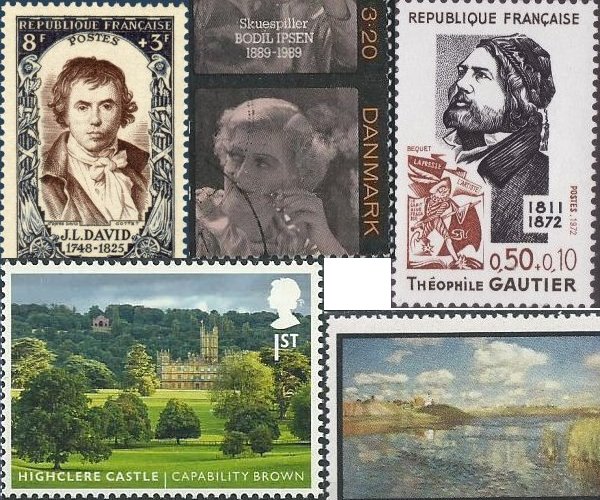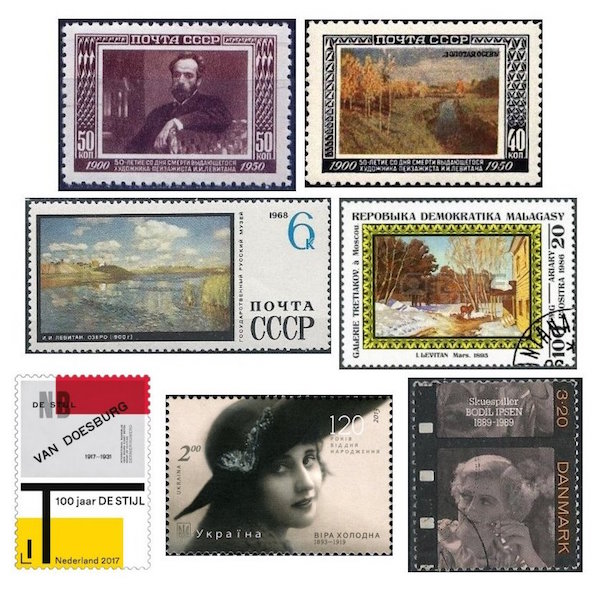The Arts on Stamps of the World — August 30
An Arts Fuse regular feature: the arts on stamps of the world.

By Doug Briscoe
Welcome one, welcome all to our fifth consecutive day of one-man shows, i.e., days on which a single artist gets a collage all to himself. With the exception of Goethe, these have all been painters, like today’s Jacques-Louis David (30 August 1748 – 29 December 1825), another French Neoclassical artist like yesterday’s Ingres. Again we begin with a self-portrait (1794), as seen on an old French stamp of 1950, but an even older one, from 1939, is a stamp celebrating the artist’s Tennis Court Oath (Serment du jeu de paume, 1791). A much more recent French issue from 1989 shows a preparatory sketch for this canvas, and another work capturing “current events” is the Assassination of Marat (1793). To round off the first row, here is a 1790 portrait of the artist by his student Antoine-Jean Gros. In the next row we begin with two evocations of Roman legend, the Oath of the Horatii (1784) and The Intervention of the Sabine Women (1799). Next to these are two examples of David’s contemporary portraiture: Madame de Verninac (the sister of Eugène Delacroix, 1798–99) and Antoine Laurent Lavoisier and His Wife (1788). At the end of the line comes a small detail from one of David’s comparatively infrequent religious pictures, this on a new British stamp of 2013, St Roch Praying to the Virgin for an End to the Plague (1780). In the final row two works glorifying the career of Napoleon are represented in five stamps: the famous Napoleon at the Saint-Bernard Pass (1801) and The Coronation of Napoleon (1806), shown complete on an issue from Guyana, with a detail recreated on a French stamp of 1973. Incidentally, a portrait of the composer François Devienne, long attributed to David, has now been downgraded to anonymous.
Another important French figure born on August 30 was poet Théophile Gautier (1811 – 23 October 1872). Besides providing lyrics for songs by many composers—including his friend Berlioz, who set six Gautier poems in the cycle “Les Nuits d’été“, Fauré, Chausson, Duparc, Reynaldo Hahn, and many more—Gautier was significant as a writer on dance, described by Edwin Denby as “by common consent the greatest of ballet critics.” Gautier provided the scenario for Adolphe Adam’s ballet Giselle as well as writing general music criticism. Indeed, he wrote more in the journalistic vein than he did as a poet, and he also wrote nine plays and three novels.
Believe it or not, there is no stamp for Mary Wollstonecraft Shelley (née Godwin; 30 August 1797 – 1 February 1851), just another example of the Royal Mail’s routine neglect of Britain’s great creative minds (there isn’t a stamp for her husband, either, you may recall). They did come out with a monster set—I mean, only four stamps, but on the subject of monsters—from which I extract the Frankenstein to appease your inner raging monster of indignation. If that’s not enough, perhaps a second rather creepy Frankenstein stamp from Palau will go far to slake your ravenous appetite for philatelic satiety. By the way, a new ballet on Frankenstein, with music by Lowell Liebermann and choreography by Liam Scarlett, was given by the Royal Ballet last autumn.

And yet, as if to disprove my precedent carping, the UK just last year did issue a beautiful set of eight stamps highlighting the work of the English landscape architect known as Capability Brown. So beautiful, indeed, is the set that I thought I must show it complete. Baptized on 30 August 1716, Lancelot Brown, to give him his proper name, was the son of a land agent and worked as a gardener after finishing school. He was named head gardener at Stowe (see upper left stamp) and was permitted to exercise his expertise for other houses. At Croome Court (see the next stamp over) he also designed the house itself. His work was all the rage and replaced the formal gardens that had previously dominated the grounds of the posh. I’ve actually had the pleasure of visiting a few of these places myself: Stowe, Alnwick (pronounced annick), and Longleat. Although Brown’s style did not long survive his death on 6 February 1783, falling as it did before the onslaughts of Romantic taste, yet the parks themselves, more than 170 of them, can in many cases still be seen today.

From actual landscapes to representational ones, we turn to Russian painter Isaac Levitan (30 August [O.S. 18 August] 1860 – 4 August [O.S. 22 July] 1900). He was born in a shtetl in what today is Lithuania. The family moved to Moscow when he was ten, and he studied art under Alexei Savrasov, among others. Through fellows artists he met Chekhov, and the two men became fast friends. The first Levitan stamps appeared on the occasion of the fiftieth anniversary of the artist’s death. The monochromatic violet 50-kopek stamp shows a portrait of Levitan by Valentin Serov (1893); and the 40-kopek companion piece offers Levitan’s own Golden Autumn (1895) A later Soviet stamp of 1968 shows The Lake (c1899), and the stamp from the Malagasy Republic gives us March (1895).
Dutch artist Theo van Doesburg (30 August 1883 – 7 March 1931) is perhaps most important historically for founding and leading the art movement De Stijl, of which Mondrian and Schwitters were disciples. Van Doesberg himself, who was born Christian Emil Marie Küpper in Utrecht, was also a writer, poet, and architect besides working as a painter. (He adopted the name Doesberg as he believed he was the natural son of a man of that name.) He had his first show of paintings in 1908. He died of a heart attack at 47. The stamp just came out this year to mark the centennial of De Stijl.

Two European actresses not much known on these shores share this August 30 birthday, the Russian silent film star Vera Kholodnaya (1893 – 16 February 1919) and the Danish actress and director Bodil Ipsen. Only five Kholodnaya films are still extant, and it seems no one knows how many she appeared in, as few as fifty or as many as a hundred, but at one point she was churning out a picture every three weeks. At 25 years of age she fell victim to the Spanish flu. Bodil Ipsen (30 August 1889 – 26 November 1964) also worked in the silents, but also had extensive experience in the theater, with a repertoire of some 200 roles. She appeared in her first film in 1920, the first of the dozen in which she acted, but she went on to direct the first Danish film noir, Afsporet (Derailed, 1942), and nine more movies before her last in 1951. She went on acting until 1960.
While we’re on the subject of actors, it happens to be the birthday of four more who are very well known to American audiences: Raymond Massey (1896-1983), Shirley Booth, (1898-1992), Joan Blondell (1906-1979), and Fred MacMurray (1908-1991). And one can only hope that someday there’ll be a stamp for the inimitable Robert Crumb (born August 30, 1943).
A graduate of the University of Massachusetts with a B.A. in English, Doug Briscoe worked in Boston classical music radio, at WCRB, WGBH, and WBUR, for about 25 years, beginning in 1977. He has the curious distinction of having succeeded Robert J. Lurtsema twice, first as host of WGBH’s weekday morning classical music program in 1993, then as host of the weekend program when Robert J.’s health failed in 2000. Doug also wrote liner notes for several of the late Gunther Schuller’s GM Recordings releases as well as program notes for the Boston Classical Orchestra. For the past few years he’s been posting a Facebook “blog” of classical music on stamps of the world, which has now been expanded to encompass all the arts for The Arts Fuse.
